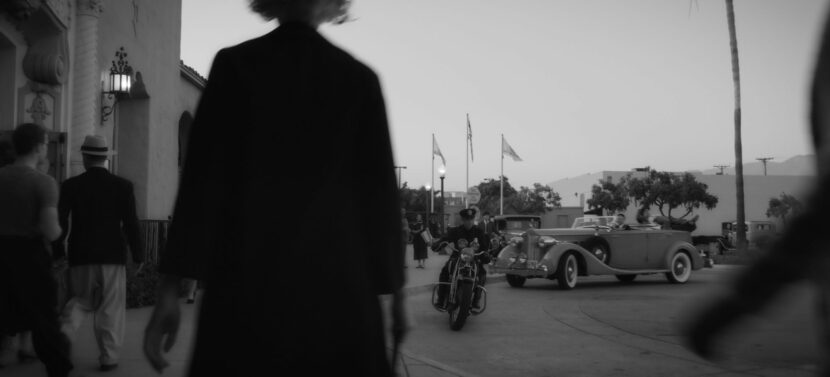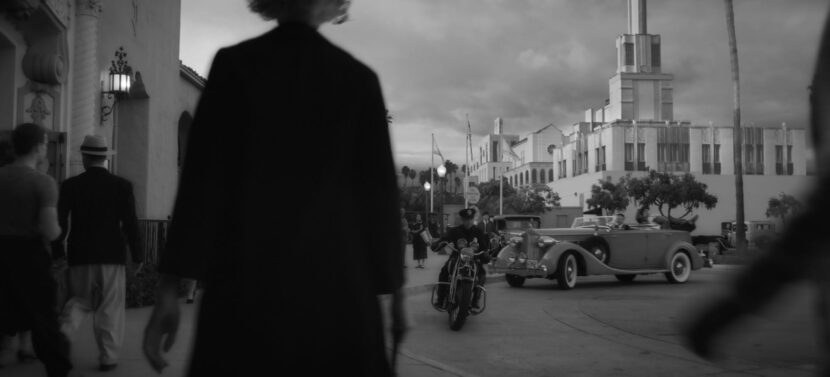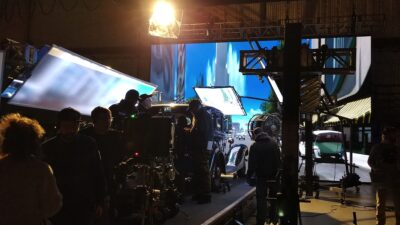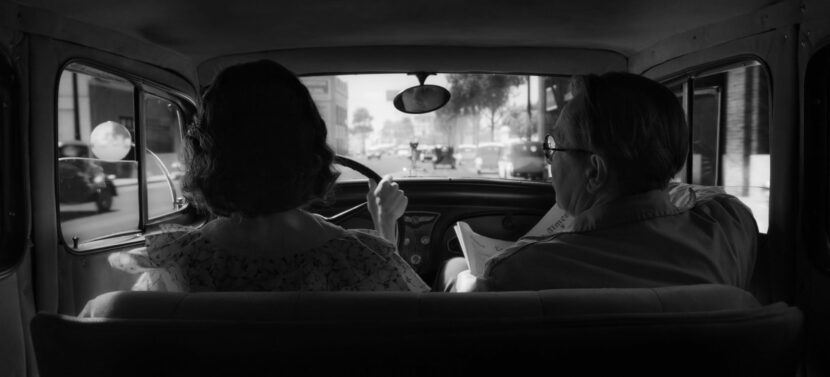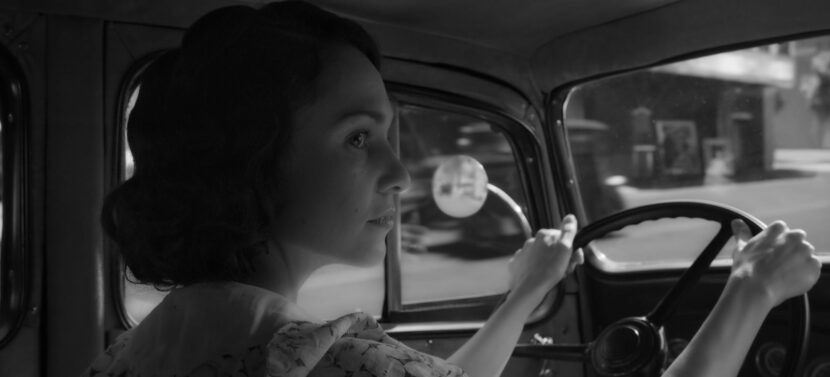Mank is nominated for 10 Academy awards in this year’s 93rd Oscars in categories such as Best Picture, Lead Actor, and Best Director. It is also nominated for the VES award for Outstanding Supporting Visual Effects in a Photoreal Feature. The film follows screenwriter Herman J. Mankiewicz’s tumultuous development of Orson Welles’ iconic masterpiece Citizen Kane (1941).
There were several VFX supervisors nominated, Simon Carr (Territory Studio), Wei Zheng (Artemple), James Pastorius (Savage VFX), along with Peter Mavromates. In many respects, director David Fincher could have also been nominated for VFX. The director is himself an expert in visual effects and was a very active contributor to the film’s effect work. Peter Mavromates is a long-time collaborator with David Fincher and was officially the Co-producer, Post Supervisor and VFX Producer on the film. Additionally, Pablo Helman at ILM was key in creating the CG animals at the San Simeon zoo.
The film had its roots going back over 20 years. “We had a false start about 20 years ago, around 1999. The script had been written at that time but it never happened for a number of reasons,” Mavromates comments. “Probably a contributing factor was that it was black and white and if you weren’t Woody Allen in the 90s, you couldn’t shoot black and white. Even Mel Brooks had to change producers for Young Frankenstein because the studio wouldn’t let him shoot black and white and he had to find another studio.”
The movie finished filming about 2 weeks before the W.H.O. declared the COVID pandemic in Feb 2020. This meant nearly all the VFX was done using remote protocols at each of the VFX vendors.
LED Screens
Simon Carr of Territory Studio headed the team that recreated a section of Wilshire Blvd using a combination of rear projection and LEDs panels. Their work was some of the only VFX to be primarily completed before the pandemic.
The Wilshire Blvd sequence required the recreation of the famous road in Hollywood. As the film was almost entirely shot in B/W on the RED Ranger Helium Monochrome camera, there was no possibility of green or blue screen for the VFX outside the windows of the car when the actors were filmed in the studio. The impossibility of using a green screen reinforced the advantage of shooting the driving scene ‘old school’ with a ‘backlit/rear projection’ approach with LED panels.
The external imagery was not done as a live dynamic LED stage setup. The exterior did not dynamically update to any camera movement. The style was much more in the historical look of the film’s period era but with the imagery generated digitally ahead of time. “When they’re driving to the beach down Wilshire Boulevard, it was actually a fully CG-created environment. It was really dealt with as sort of old-fashioned rear projection,” comments Mavromates.
Locations
Wei Zheng of Artemple headed the team that was responsible for many of the extended locations and sets. Mavromates describes Zheng as Fincher’s favorite digital matte painter, and thus Zheng did all the major matte painting and projection environments in the film. Artemple did detailed work to bring the filming locations back to the 1930s era and into the golden age of Hollywood. This was the sixth collaboration for Zheng with the director. Commenting on Deadline.com Zheng stated that “I’m pretty lucky that since Zodiac, I’ve had the opportunity to work for David (Fincher) and Peter (Mavromates), and I know what David’s looking for, in terms of aesthetic.”
Skies
Savage VFX did the complex and flexible sky replacement through an unusually long San Simeon sequence. The company used the real-time Unreal game engine to produce the shots. Savage added clouds to the sequence where Mank meets Hurst for the first time. Instead of doing a series of matte paintings in post to match the edit, the team decided to make a 360 degree CG cloud environment with Houdini and UE4. This was used from the earliest stages of lookdev to the final comps. For the early staging and framing, an entire virtual set with all the props and set pieces was used to visualize the shots. It was then possible for the clouds to be placed consistently and be crafted to the very distinct style of the film. Not only did the UE4 environment place the clouds but the setup matched all the cameras, framing, aperture, time of day, and focal length accurately. After the cloud shots were approved, the UE4 setup was exported to Houdini for rendering and composited in Nuke with the addition of lens flares and any additional elements.
Cinematography
Mank was shot by DOP Erik Messerschmidt, who photographed the film using the Red Monochrome cameras as a native black and white film with a period-appropriate deep focus. His work distilled the visual storytelling to lighting with shadow and texture, producing a film that looks modern but respects the filmmaking era of the story.
The film was shot on Red Ranger Helium Monochrome cameras primarily. A lot of time was spent in pre-production coming up with the final look and this involved a signature look of blooming the blacks on screen, a common film artifact from the early days of cinema. “Erik worked to understand the formulas of when this appeared and didn’t appear in each lighting situation and then he married that with a series of grain tests to come up with grain structures that worked with those blooming blacks,” explains Mavromates. “There are also some in-camera fades, and a small handful of in-camera f-stop pulls, so that the depth of field changes during a shot. It is very subtle, but these were things that Gregg Toland (DOP) did in the actual Citizen Kane movie.”
Earlier in his career, director David Fincher prepared by creating highly detailed technical pre-viz, but for some time Fincher has moved away from creating that style of previz. Mavromates was the post-production supervisor on Panic Room and he points out that Fincher has done “very little Previz since Panic Room (2002). He likes to shoot a movie with VFX – like he would shoot it if it had no VFX.” He locked onto that methodology for The Curious Case of Benjamin Button (2008), because he didn’t want it to feel like any shot looked like it was filmed to serve the visual effects in the film… “and this is partly because the technology has come such a long way. And so now there is a bit of a freestyle nature to the way that we film things.”
ILM did get a small set of VFX shots for Mank for the digital animals. For one sequence where a monkey case and digital monkeys were going to be in shot, “David put a lit up white panel behind the stone iron fence where he wanted the monkey cage to go.” says Mavromates. There was not use putting up green screen as the sequence was shot in black and white, but Fincher and Mavromates wanted to give ILM some help in isolating the foreground.
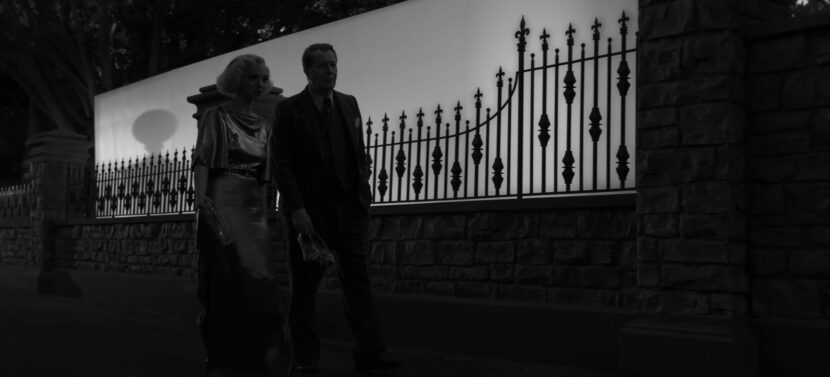
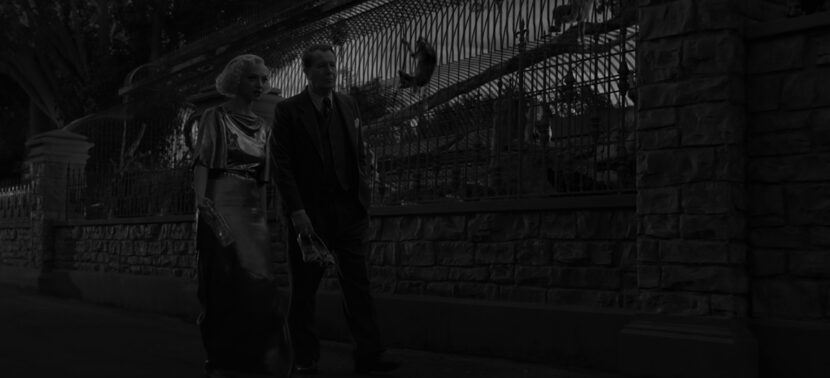
ILM did 7 creature shots with digital monkeys, giraffes, and elephants. Savage VFX did 233 shots, and Artemple did 72 shots, which was almost all digital matte paintings. Territory Studios in the UK did the Wilshire Blvd work that ended up as 7 shots in the film, “but the amount of work they did is far larger than that number indicates.” Ollin VFX in Mexico did 228 shots and “I have a company called Outback Post, who I call my ‘optical’ company,” comments Mavromates. Outback did many of the transitions, adjustments, split screens, and what would have been optical effects in the film age of cinema but today are actually much more complex than anything done in the optical days of film. “I would say starting with The Girl with the Dragon Tattoo, we have not been shy about saying, ‘hey I know, that’s a handheld shot, but we’re going to do a split-screen and I’m putting these two performances together and, you know, Outback get it done.”
The film’s VFX and post were DI mastered at 6K from which the master is extracted. This extra resolution allows the filmmakers to do some blowup or repositioning work right up until the end of post-production. The Red cameras source footage at 8K is twice the resolution of Netflix’s final deliverable. The final 4K master is done as the very last process.
Mavromates also ran a small VFX crew in-house because David Fincher “knows this technology and is he’s not shy about using it all the way until the very last day when we can’t work on it anymore.” Mavromates recalls on a previous film that in the very last days of the final grading, Fincher decided that the position of a light switch on the wall was slightly distracting and he had his team “move it digitally over about a foot.” Adding, “the cumulative effect of all of that is just a high level of control that does actually end up on the screen and does make a difference.”

